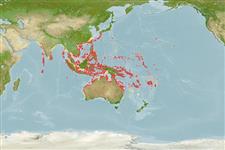Actinopterygii (ray-finned fishes) >
Perciformes (Perch-likes) >
Nemipteridae (Threadfin breams, Whiptail breams)
Etymology: Scolopsis: Greek, skolex = worm + Greek, opsis = appearance (Ref. 45335).
Environment / Climate / Range
Ecology
Marine; reef-associated; depth range 1 - 25 m (Ref. 9710). Tropical, preferred ?; 32°N - 36°S, 66°E - 172°W (Ref. 3810)
Indo-West Pacific: Maldives (Ref. 11303) and the Laccadive Islands to Fiji, north to southern Japan, south to Lord Howe Island. Recently reported from Tonga (Ref. 37816).
Size / Weight / Age
Maturity: Lm ? range ? - ? cm
Max length : 25.0 cm TL male/unsexed; (Ref. 90102); common length : 13.0 cm SL male/unsexed; (Ref. 3810)
Common on coral reefs. Adults occur on most reef habitats, usually in pairs, and juveniles inshore or in lagoons or rubble zones (Ref. 48635). Occurs singly or in small aggregations. Feeds on small fishes and benthic invertebrates. A protogynous hermaphrodite (Ref. 9785). Juvenile mimics poison-danged blenny Miacanthus grammistes, Batesian mimic (Ref. 90102).
Life cycle and mating behavior
Maturity | Reproduction | Spawning | Eggs | Fecundity | Larvae
Russell, B.C., 1990. FAO Species Catalogue. Vol. 12. Nemipterid fishes of the world. (Threadfin breams, whiptail breams, monocle breams, dwarf monocle breams, and coral breams). Family Nemipteridae. An annotated and illustrated catalogue of nemipterid species known to date. FAO Fish. Synop. 125(12):149p. Rome: FAO. (Ref. 3810)
IUCN Red List Status (Ref. 115185)
CITES (Ref. 94142)
Not Evaluated
Threat to humans
Harmless
Human uses
Fisheries: subsistence fisheries; aquarium: commercial
More information
ReferencesAquacultureAquaculture profileStrainsGeneticsAllele frequenciesHeritabilityDiseasesProcessingMass conversion
Tools
Special reports
Download XML
Internet sources
